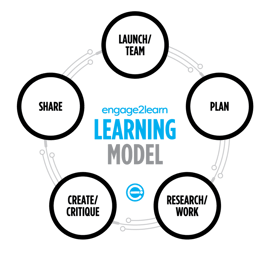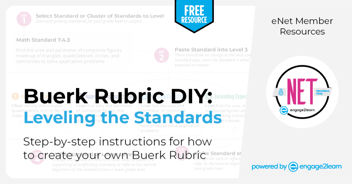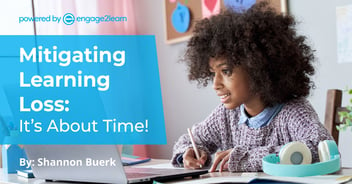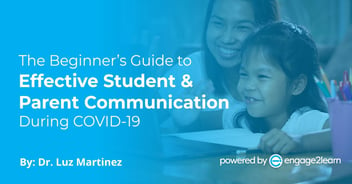How to make Remote Learning work for every learner! | engage2learn
The results are in for remote learning…It didn’t work
This spring, educators worked around the clock, day and night, to transition from onsite to remote learning. Despite their Herculean efforts and to no one’s surprise given the circumstances, reports abound with data proving that the last few months of 19-20 fell short in terms of engagement and achievement, especially for the most vulnerable of students.
Projections from the NWEA, an Oregon-based nonprofit, suggest that “students nationwide will return to school in the fall with roughly 70% of learning gains in reading relative to a typical school year, and less than 50% in math,” according to the Wall Street Journal. Students from low-income families and special education learners have fared even worse. Recent findings published by NPR report that these student populations “are twice as likely to say remote learning is going poorly (36% vs. 18%).” ParentsTogether, an education advocacy group, further estimates that four out of 10 “of the poorest U.S. students” only accessed remote learning once weekly or less.
Educators don’t need to see the reports, though; they know things have to be different. This academic year is most likely to be a full year of remote learning in many communities and in all locations for some students. At least, this time, there are a few months to plan for it. Every educator I know is focused on learning from what they did well and not so well this spring to craft a better plan for 20-21.
So why didn’t remote learning work?
The answer is simple: we tried to make at-home learning teacher-directed rather than learner-directed.
We built schedules for teachers to follow, that resulted in too much time for learners to be online. We set up whole group video “classrooms” for whole group instruction, which is even less effective virtually than in person. Families were forced to shift from parental roles into those of educators. Even with an abundance of free resources made available from school districts and educational organizations (like our Parent Toolkit for School Closures), this was too much of an ask. Students who do not have a family member who can serve as teachers fell further behind. Or worse, we provided “personalized” software that reduced school to completing online courses without any of the engagement that comes from interacting with other humans. From the numerous conversations we’ve had with our district partners as necessities for the unprecedented 20-21 school year ahead of us, they say–and I agree–we have to be able to do the following:
- Mitigate learning loss
- Truly differentiate for every learner
- Engage learners more
- Ensure that learning is more cohesive
- Focus on mastery
- Address equity!
What did work? A Learner-Directed Model
What, then, is the answer to make this work and to address all of the concerns mentioned above? Again, it is simple: put the learner in the driver’s seat. Design the experience for learners to have autonomy and exercise agency, to make choices, to have different entry points and pathways and track their learning along the way. Like most institutions, our current education model has primarily been constructed from and for the viewpoint of the “manager,” or, in this case, the teacher. Flipping the concepts of time, space, content, and method on its head and designing from the viewpoint of the learners can change everything about the experience and ensure better student outcomes.
As recently as 2017, a group of psychology and education students joined forces to investigate the “why” behind student autonomy as the anecdote. Their findings were unanimous: when teachers encouraged learner autonomy, “students tended to be less bored, to have higher feelings of self-efficacy, and to see their schoolwork as having intrinsic value,” (source).
More importantly, every one of our 47 district partners who used their learner-directed models this spring are reporting great results in student engagement, student achievement, teacher satisfaction, and family satisfaction. Here are some of their testimonials about what worked:
“Our ability to put EPISD@Home in place so effectively is attributed to the soft skills we have learned in agility and creativity over the past five years rolling out the Active Learning Framework, and the Active Literacy Framework, which have reshaped the EPISD learner experience entirely.” Superintendent, EPISD
“We are designing 20-21 with all of our learners in mind first. Then we have to make sure that we provide ongoing support to our amazing staff to implement the strategy that is going to work best for our learners and their families. And, we want to use a strategy that works regardless of how the context shifts.” Cara Cooke, Superintendent, Aransas Pass ISD
“Our team remembered the Uvalde CISD Paw Print; the blended learning framework designed by our strategic design committee for the 2020-2021 school year. The third stage of our framework is “Personalize,” which challenges teachers to give students more voice and choice in how they learn the content in (or in this case out of) the classroom. We dug into the components and best practices aligned at each stage of the framework and realized that this was exactly what we needed to align instruction at all levels and content areas. BINGO!” Natale Arias, Project Lead, Uvalde CISD
e2L Learning Model: Future Proof for Learning
After hearing from our partners and realizing that this type of model would make a difference for everyone, we made a momentous decision at engage2learn (e2L). Why don’t we give away our proven e2L Learning Model to the world of education for free?
I designed this learner-centered model myself 10 years ago, and we have now been using it for those 10 years with learners state and nationwide; the e2L Learning Model is research-based with proven results. It provides defined structure and protocols that guide the design and facilitation of each learner’s experience across your entire district…even if that learning is taking place remotely. We know that every dime of our partner districts’ budgets matter, and now more than ever, we understand that every minute of your instructional design is critical.
The idea behind the e2L Learning Model was to create a learner-directed model that ensures achievement and life ready skills in one thing that could be used in every neighborhood school rather than only in choice campuses. And because this model puts learners in the driver’s seat, it works across remote or in-person learning environments because of the autonomy it cultivates. You’ve heard “learner-directed learning” called many things: Project-based Learning, Inquiry-based Learning, Challenge-based Learning, Blended Learning, etc. But in the end, isn’t it really JUST LEARNING? This structure provides a simple, common vocabulary to guide learners, teachers, and families in a unified way through the natural learning process.
The e2L Learning Model is supported by behavioral protocols that clearly define and describe what learning looks like from the perspective of every participant in the learning process: teacher, student, and now, family. You can find these protocols that describe what teachers, learners, and (most recently updated to also include) families do during each step of the model on our website.
By contrast, the teacher-directed model of education uses an instructional model that outlined only the teacher’s role, which requires the learner to rely on the teacher at all times. Because the learner is not involved in the process, most students never know what instructional model their teacher is using: they just wait for the next instructions. This equates to a lot of wasted time for many learners.
BONUS BENEFIT: Equity of Experience

The e2L Learning Model provides equitable access to rigorous and relevant learning experiences for students in any scenario because the learning is in the hands of the learner. It doesn’t depend on the families to be involved. It doesn’t depend on physical space or classrooms, and it doesn’t have a one-size-fits-all approach for learners. True differentiation can only happen when each student can follow a self-directed pathway so that learning can be accelerated and no time is wasted. To increase both engagement and equity in remote learning, districts must utilize a learner-facing model.
Need further convincing? Hear what students have to say about their experience with the e2L Learning Model and how it has propelled their educational career forward. If you are a current or previous partner, drop your testimony in the comments below.
You’re convinced. Great! How do we roll it out?
We’re so pleased that you’ve chosen the e2L Learning Model as your model for defining the type of learning experience you want your students to have. Regardless of the environmental context we all find ourselves in through the coming school year(s), we want every public neighborhood school to thrive this year!!!
Everything you need to implement this model is on our e2L Learning Model Resource page. You will find the model, the protocols for learners, teachers, and families, printable templates, implementation guide, and free online course. This resource includes everything you need to help you define the most critical moves necessary to implement this model in a strategic, systemic manner effectively.
Don’t forget these important pro tips for implementing a learner model:
- Align your initiatives, educational best practices, and curriculum to it. Read more about this step in my previous blog: How to Turn 1,000 Initiatives into One Thing.
- Roll out the learning model to teachers, learners, AND their families! We even have a free workspace to help you plan for a Responsible Rollout based on your district’s needs and goals.
- Teach the protocols to your teachers.
- Have teachers organize lessons according to the steps of the model and provide resources for learners aligned to the steps and the standards.
- Ask teachers to teach the steps and the protocols to learners
- Create videos to share the ideas with families.
- Provide ongoing support to teachers as they shift in person and remote practice to a learner-directed model.



